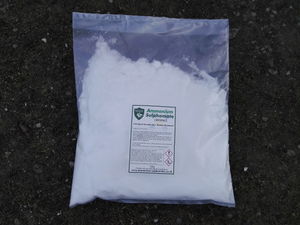Ammonium sulfamate
 Ammonium sulfamate crystals
| |
| Names | |
|---|---|
| IUPAC name
Ammonium sulfamate
| |
| Other names
Amicide
Ammate X-NI Ammonium amidosulfonate Ammonium sulphamate | |
| Properties | |
| H6N2O3S | |
| Molar mass | 114.125 g/mol |
| Appearance | White crystalline solid, hygroscopic |
| Odor | Odorless |
| Density | 1.8 g/cm3 |
| Melting point | 131 °C (268 °F; 404 K) |
| Boiling point | 160 °C (320 °F; 433 K) (decomposes) |
| 197.8 g/100 ml (25 °C)[1] | |
| Solubility | Soluble in ethylene glycol, formamide, glycerol, liq. NH3 Insoluble in diethyl ether, ethanol, methanol, n-octanol |
| Vapor pressure | ~0 mmHg |
| Acidity (pKa) | 6 |
| Hazards | |
| Safety data sheet | Sigma-Aldrich |
| Flash point | Non-flammable |
| Lethal dose or concentration (LD, LC): | |
| LD50 (Median dose)
|
2,000 mg/kg (rat, oral) 3,100 mg/kg (mouse, oral) |
| Related compounds | |
| Related compounds
|
Sulfamic acid |
| Except where otherwise noted, data are given for materials in their standard state (at 25 °C [77 °F], 100 kPa). | |
| Infobox references | |
Ammonium sulfamate (or ammonium sulphamate) is a white crystalline solid, readily soluble in water. It has the formula H6N2O3S, also written NH4SO3NH2.
Contents
[hide]Properties
Chemical
Ammonium sulfamate reacts with benzamide at high temperatures to form benzonitrile.
Physical
Ammonium sulfamate is a hygroscopic white solid, soluble in water.
Availability
Ammonium sulfamate is sold as compost accelerator, and it's very pure. In UK, it is sold by Lancelot Garden Products and can be bought in 1, 5, 10 or 25 kg bags.
Ammonium sulfamate is no longer an accepted herbicide in the EU since 2008[2] due to the Irish Rapporteur not receiving testing on dogs for said chemical and thus the compound did not receive the license to be allowed as herbicide.[3] However, ammonium sulfamate is still legally allowed to be used as compost accelerator. Since both products are found in the same section of most stores (gardening) or online stores just a click away, nothing will stop anyone who knew that the compost accelerator can also be used as herbicide to, well, use it as herbicide.
Preparation
Ammonium sulfamate can be prepared by neutralizing sulfamic acid with ammonia. Ammonium bicarbonate can also be used.
- (OH)SO2(NH2) + NH3 → NH4SO3NH2
To limit hydrolysis, the reaction temperature must be kept below 50 °C.
Sodium chlorosulfonate (which can be obtained from the reaction of chlorosulfuric acid or sulfur trioxide with dry sodium chloride) reacts with ammonia at -33 °C to form ammonium sulfamate, at around 53% yield. The reaction is describe as vigorous. Ammonium sulfate and ammonium imidodisulfonate are produced as side products.[4]
- NaSO3Cl + 2 NH3 → NH4SO3NH2 + NaCl
Projects
- Make guanidinium sulfate
- Herbicide and compost accelerator in gardening
Handling
Safety
Ammonium sulfamate is considered to be slightly toxic to humans and animals, making it appropriate for amateur home garden, professional and forestry uses. It is generally accepted to be safe for use on plots of land that will be used for growing fruit and vegetables intended for consumption.
It is also considered to be environmentally friendly due to its degradation to non-harmful residues.
Storage
In closed airtight bottles or bags, since it's hygroscopic.
Disposal
No special disposal is required. You may dilute it in water and pour it down the drain or dump it over weeds.
References
- Jump up ↑ Standritchuk, O. Z.; Maksin, V. I.; Zapol'skii, A. K.; Russian Journal of Physical Chemistry; vol. 63; nb. 9; (1989)
- Jump up ↑ https://www.allotment-garden.org/garden-diary/1989/ammonium-sulphamate-weed-killer-banned/
- Jump up ↑ https://web.archive.org/web/20091113071628/http://www.pesticides.gov.uk/garden.asp?id=1997
- Jump up ↑ H. H. Sisler and L. F. Audrieth, The Action of Liquid Ammonia upon Sulfur Trioxide Addition Compounds, J. Am. Chem. Soc. 1939, 61, 12, 3392–3393